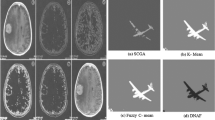Abstract
This paper presents a new region-based segmentation scheme which considers homogeneous regions as constituted of pixel blocks that are highly similar to their neighborhoods. Based on the postulate that each homogenous region can be represented by an exemplary pixel block, segmentation is done by grouping contiguous pixel blocks whose neighborhoods are highly similar to the exemplary pixel blocks. In our approach, the degree of similarity between one pixel block and its neighborhood is determined via fuzzy similarity, while the exemplary pixel blocks are automatically discovered by Kohonen self-organizing map. The discovered pixel blocks are later used to split the image into its constituent regions. To obtain a more discernible result, a two-stage iterative merging technique based on Region Adjacency Graph (RAG) is applied. The proposed scheme has been evaluated using real images with results that are comparable and in certain cases better than the morphological watershed segmentation.
Access this chapter
Tax calculation will be finalised at checkout
Purchases are for personal use only
Preview
Unable to display preview. Download preview PDF.
Similar content being viewed by others
References
Zhang, Y.J.: An Overview of Image and Video Segmentation in the Last 40 Years. In: Zhang, Y.J. (ed.) Advances in Image and Video Segmentation, pp. 1–15. IRM Press, Hershey PA (2006)
Zhang, Y.J.: Evaluation and Comparison of Different Segmentation Algorithms. Pattern Recognition Letters 18, 963–974 (1997)
Meyer-Bäse, A.: Neural net computing for image processing. In: Jähne, B., Haußecker, H., Geißler, P. (eds.) Handbook of Computer Vision and Applications, vol. 2, pp. 729–751. Academic Press, San Diego (1999)
Ahmed, M.N., Farag, A.A.: Two-stage Neural Network for Volume Segmentation of Medical Images. Pattern Recognition Letters 18, 1143–1151 (1997)
Reddick, W.E., Glass, J.O., Cook, E.N., Elkin, T.D., Deaton, R.J.: Automated Segmentation and Classification of Multispectral Magnetic Resonance Images of Brain Using Artificial Neural Networks. IEEE Transactions on Medical Imaging 16, 911–918 (1997)
Ong, S.H., Yeo, N.C., Lee, K.H., Venkatesh, Y.V., Cao, D.M.: Segmentation of Color Images Using a Two-Stage Self-Organizing Network. Image and Vision Computing 20, 279–289 (2002)
Sonka, M., Hlavac, V., Boyle, R.: Image Processing, Analysis and Machine Vision, 3rd edn. Thomson, Toronto (2008)
Coatrieux, G., Solaiman, B.: A Pixel Block Fuzzy Similarity Measure Applied in Two Applications. In: 1st IEEE Int. Conf. on Information and Communication Technologies: from Theory to Applications, pp. 355–356 (2004)
Haris, K., Efstratiadis, N., Maglaveras, N., Katsaggelos, A.K.: Hybrid Image Segmentation Using Watersheds and Fast Region Merging. IEEE Transactions on Image Processing 7, 1684–1699 (1998)
Tan, W.H., Coatrieux, G., Solaiman, B., Besar, R.: A Region Based Segmentation Using Pixel Block Fuzzy Similarity. In: 2nd IEEE Int. Conf. on Information and Communication Technologies: from Theory to Applications, pp. 1516–1521 (2006)
Klette, R., Rosenfeld, A.: Digital Geometry: Geometric Methods for Digital Picture Analysis. Morgan Kaufmann, San Francisco (2004)
Russ, J.C.: The Image Processing Handbook, 5th edn. CRC Press, New York (2007)
Kohonen, T.: Self-organizing Maps. Springer, Berlin (2001)
Sarkar, A., Biswas, M.K., Sharma, K.M.S.: A Simple Unsupervised MRF Model Based Image Segmentation Approach. IEEE Transactions on Image Processing 9, 801–811 (2000)
Hernández, S.E., Barner, K.E.: Joint Region Merging Criteria for Watershed-Based Image Segmentation. In: Int. Conf. on Image Processing 2000, pp. 108–111 (2000)
Duarte, A., Sánchez, A., Fernández, F., Montemayor, A.S.: Improving Image Segmentation Quality Through Effective Region Merging Using a Hierarchical Social Metaheuristic. Pattern Recognition Letters 27, 1239–1251 (2006)
Pichel, J.C., Singh, D.E., Rivera, F.F.: Image Segmentation Based on Merging of Sub-optimal Segmentations. Pattern Recognition Letters 27, 1105–1116 (2006)
Author information
Authors and Affiliations
Editor information
Editors and Affiliations
Rights and permissions
Copyright information
© 2011 Springer-Verlag Berlin Heidelberg
About this paper
Cite this paper
Tan, WH., Coatrieux, G., Solaiman, B., Besar, R. (2011). A Fuzzy Similarity Based Image Segmentation Scheme Using Self-organizing Map with Iterative Region Merging. In: Badioze Zaman, H., et al. Visual Informatics: Sustaining Research and Innovations. IVIC 2011. Lecture Notes in Computer Science, vol 7066. Springer, Berlin, Heidelberg. https://doi.org/10.1007/978-3-642-25191-7_22
Download citation
DOI: https://doi.org/10.1007/978-3-642-25191-7_22
Publisher Name: Springer, Berlin, Heidelberg
Print ISBN: 978-3-642-25190-0
Online ISBN: 978-3-642-25191-7
eBook Packages: Computer ScienceComputer Science (R0)




